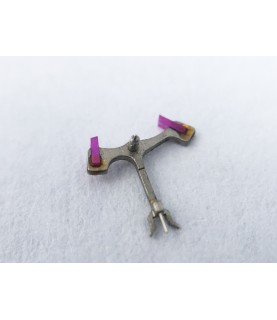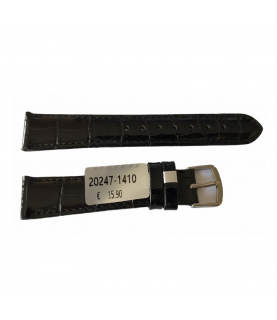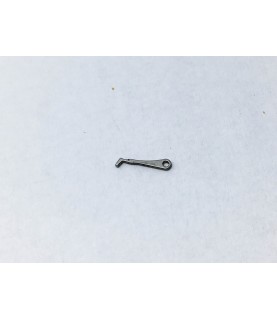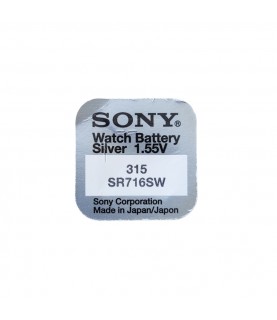Beneath the Lunar Surface: Omega Speedmaster Dark Side of the Mo
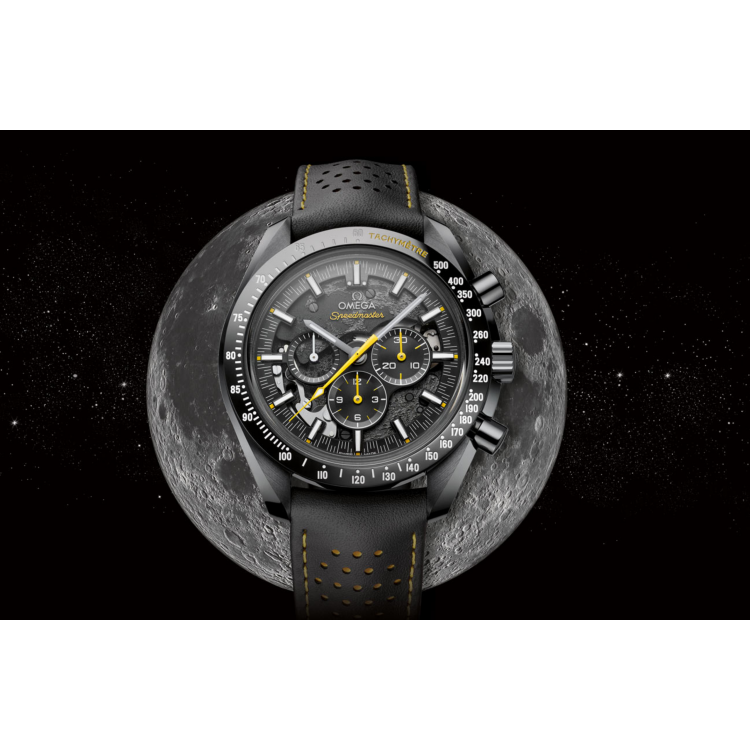
Omega expanded its Speedmaster Dark Side of the Moon collection with the new Apollo 8 edition, whose laser-engraved, skeletonized movement takes this ceramic-cased version of the legendary Moonwatch to new aesthetic heights. Most watch aficionados can recall what a seismic event it was when Omega released the first Dark Side of the Moon version of its iconic Speedmaster Professional "Moonwatch" back in 2013. But few of them probably could have predicted that this very avant-garde take on one of Omega's most timeless watch designs would catch fire the way it did, especially considering the very passionate fan base of the vintage model and the general resistance to change; there is a reason that Omega continues to equip many of its Moonwatches with basically the same manual-wind movement as their 1969 predecessor, after all.

However, the Dark Side of the Moon has not only thrived but has become a legitimate franchise of its own, spinning off from the main Speedmaster family and used as the proving ground for a number of intriguing designs and technical ideas. In 2018, a year in which Omega devoted much of its marketing muscle not to the Speedmaster but to its dive-watch predecessor, the Seamaster, there was among the flood of Seamasters one very notable return to the Dark Side: the Speedmaster Dark Side of the Moon Apollo 8, a tribute to the historic 1968 lunar mission that marked its 50th anniversary in 2018. That mission was the second manned space-flight launched in the Apollo program and the first to leave Earth's orbit, reach and orbit the Moon, and return safely to Earth. It paved the way for the more famous Apollo 11 mission in 1969, which first landed men on the Moon and from which the Omega Speedmaster, the watch worn by those men on the lunar surface, earned its enduring " Moonwatch" nickname. The watch is, most notably, the first Speedmaster Moonwatch to contain a skeletonized version of the watch's storied movement, Caliber 1861. However, as I realized after having the chance to spend two weeks with this timepiece, the skeletonization is just the tip of the aesthetic iceberg.

To start with the exterior, Omega has outfitted the Apollo 8 in a 44-mm-diameter case, 13.8 mm thick, made entirely of jet-black zirconium oxide ceramic, with a polished ceramic tachymeter bezel, bearing white numerals and indexes and the word "TACHYMÈTRE" in bright yellow. The use of this highlight color, which is associated with speed and which we'll also find elsewhere on the watch's dial and strap, is a callback to the Omega Speedmaster Racing model from 1968, as is the tachymeter feature itself: as its name implies, the Speedmaster chronograph was a watch built for timing auto races long before it became inextricably linked with space exploration. The case is exquisitely finished, employing both polishing and satin brushing, with the middle curving elegantly into the faceted lugs (though, like most all ceramic case, it is very susceptible to being marred by fingerprints). The plunger-style chronograph pushers are in polished black, and subtly rounded on the top for tactile comfort. A rather firm push is required to engage the chronograph and halt it with the top pusher and to return the yellow, arrow-tipped chronograph seconds hand to zero with the bottom one. Nestled between the two pushers is the polished black, fluted crown, which does not screw down and is inscribed with the Greek letter Omega, a brand emblem.

Moving on to the dial, the yellow highlights include the central chronograph hand, which has a varnished finish, the small chronograph hands on the subdials at 3 and 6 o'clock, and the tips of the rectangular, applied indexes. Meanwhile, a white varnish is used for the small seconds hand on the 9 o'clock subdial, and white Super-Lumi-Nova coats the hands and hour indexes as well as all the indications on the bezel's tachymeter scale. Between these markers, on a black ring, is a minutes scale also reminiscent of the one used on the Speedmaster Racing models. These slightly conical subdials float like satellites over the front side of the exposed, beautifully openworked movement, upon which laser ablation has been employed to decorate both sides of the blackened mainplate and bridges with realistic 3-D depictions of the moon's surface. From the dial side, the effect is executed in a lighter gray shade and echoes the view of the moon that we see from Earth, while the rear side, visible through a clear sapphire caseback window, is darker gray, aping the eponymous "dark side" that only astronauts have ever viewed in person. As one would expect, these realistic lunar details come to life under a loupe, adding a great deal of individualistic character to this Moonwatch.

Legibility-wise, the effect of all this detail is a mixed bag. The white hour indexes and especially the prominent yellow chronograph seconds hand are easy to discern in all lighting conditions. The motion of the running seconds at 9 o'clock is also fairly obvious at a glance, allowing the wearer to check whether watch is running – an important feature in a manually wound watch. However, the relative thinness of the hour and minute hands – thin enough, in fact, to occasionally get a bit lost among the background details, and at times even obscured by the much more noticeable central seconds hand – was somewhat unexpected and a little vexing. I would have thought these hands would be at least as wide as the indexes on which they indicated the time. That said, it is possible that the watch, like some other chronographs, was designed to emphasize the stopwatch functions over the reading of the current time – and of course, the luminous tachymeter scale attests to that as well, allowing the wearer to time racing speeds even in the dark if he wishes.

Speaking of the case's rear side, whose sapphire window affords a view of the decorated movement, its brushed black ceramic frame offers historically inspired, engraved text indicating the date of the Apollo 8 mission (December 1968) and the famous quotation, "We'll see you on the other side," spoken by Command Module Pilot Jim Lovell just before the Apollo 8 crew drifted out of range of radio contact on its history-making journey to the Dark Side of the Moon (also engraved on the caseback). The movement itself – whose lunar-land-scape-finished bridges and plates add visual appeal to an already attractive architecture, and should wow even the most seasoned connoisseurs of the Speedy and its famous caliber – is based on the same historical chronograph-equipped movement inside the first Speedmaster that went to the moon in 1969, Omega's manual-wound Caliber 1861, based on the Lemania 1873. While this vintage-derived caliber is still used for the mainstream Speedmaster Professional "Moonwatch" models, the Apollo 8 represents the first time it's been used in a Dark Side of the Moon watch; previous models have been equipped with the self-winding, co-axial chronometer-certified Caliber 9300, whose chronograph readout has two registers rather than three.
 Of course, the movement is also the first of its kind to be skeletonized and enhanced with the laser-ablation finishing. This version of the
Of course, the movement is also the first of its kind to be skeletonized and enhanced with the laser-ablation finishing. This version of the
legendary Moonwatch movement has been dubbed Caliber 1869, in honor of 1969, the year of the moon landing – though one wonders why Omega didn't just change the "8" in the reference number as well, just to make the tribute more obvious. The movement holds a 48-hour power reserve when fully wound; it has no stop-seconds function but does incorporate a decoupling mechanism that prevents the mainspring from being overwound. Owners of previous Dark Side of the Moon watches who have become accustomed to not needing to wind their timepiece daily may miss that convenience at times, though this watch was very easy to wind and kept time very accurately even after more than a day and a half of being idle. Of course, the dial's visual beauty was surely taken into consideration by the designers as much as its timekeeping duties, and a large rotor, as one would find in a self-winding caliber, would most likely have been a detriment to the view of the decorated movement parts.

Finally, we come to the pebbled black leather strap, which is perforated in the style of vintage racing gloves (another nod to the Speedy's early motorsports-inspired style) and continues the black-and-yellow motif of the dial. Black on both the top and the underside, the strap includes, sandwiched between these layers, a yellow rubber middle section, which can be glimpsed through the micro-perforations made by a special milling tool. This somewhat subtle effect is enhanced by yellow contrast stitching on the topside.

The black ceramic pin buckle, with polished finish and engraved Omega symbol, has a wide tongue that inserts nicely into the rectangular holes for a secure and comfortable wrist fit. Carrying a two-year warranty, a now-common attribute of Omega watches, and packaged in a special presentation box, a now-common feature of Moonwatch special editions, the Omega Speedmaster Dark Side of the Moon Apollo 8 is priced at $9,750. With its vintage Speedmaster design elements, first-of-its-kind openworked and decorated movement, and historical lineage, I expect many, many potential owners to be "over the moon" for this timepiece.

